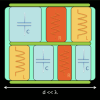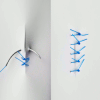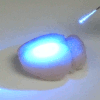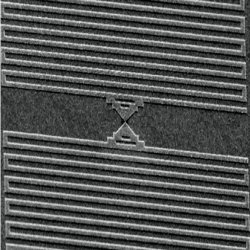-
Viewpoint on 'IONS'
Viewpoint on 'Scientific Literacy'
- Proudly sponsored by
-


-
Twisting the Knob of Light

Tuning nano-antennas may soon become as simple as tuning a radio to our favorite station — this is the new promise of nano-photonics.
-
Long Live the Polymer!

A new class of polymer that self-heals when exposed to ultraviolet light has been developed. Could this be the dawn of a technological future with self-healing materials?
-
Spooky Light

Many are afraid of darkness, but who gets spooked by light? Light has now been used to condition rats to fear, teaching us about fear memory formation.
Volume 12 Story 2 - 19/1/2011

The human eye is one of the most reliable natural light detectors… nevertheless, it is limited. In order to overcome its limitations, scientists and engineers have come up with various techniques to detect and even count photons where our eyes fail. Now, researchers at Eindhoven University of Technology in the Netherlands, Ecole Polytechnique Fédérale de Lausanne in Switzerland and Istituto di Fotonica e Nanotecnologie in Rome, Italy, have come up with a detector that can count single photons with the unprecedented spatial resolution of 50 nanometers.
Conventional photon detectors count the number of incident photons by converting them into electrical signals which can then be collected and processed with standard electronic devices. However, when the light source is as tiny as a single molecule, it is very difficult to count the few emitted photons by means of conventional detectors. A possible solution in such situations would be to place a tiny detector next to the light source so that it can directly sense the electromagnetic field of the emitted photon, thus providing high sensitivity and high resolution [1] .
Thinking along these lines, David Bitauld’s group (Eindhoven), together with colleagues from Lausanne and Rome, were able to detect and count photons at the nanoscale using a meandering superconducting nanowire with a constriction at its center. Superconducting materials can sustain current without applying any voltage if kept below their critical temperature — usually a few degrees above absolute zero. When the nanowire is, therefore, kept just below its critical temperature, any further increase in the current breaks the superconductivity of the structure and a voltage pulse can be measured. When a photon is absorbed at the constriction, the local temperature is increased, forming a hot spot with a diameter of a few nanometers. As the current through the meanders is increased beyond the critical point, a voltage pulse, the trademark of the counted photon, is measured. By adjusting parameters such as the size of the constriction, the amount of photons detected can be tuned [2]. Bitauld and coworkers’ experiment went a step further in characterizing both the spatial resolution and the sensitivity of such detector. The result? This device can count a single photon with a submicron spatial resolution of 50 nanometers.
Speaking on the future prospects of such nanoscale photon detectors, Bitauld says: "We think that these detectors can be fabricated on a scanning probe tip. This will allow us to obtain near-field images of photonic devices with high resolution and high sensitivity." An interesting application for these detectors, in particular, could be the study of the behavior of quantum emitters, such as quantum dots or single molecules. "Resolving the number of emitted photons can be of great interest, for example, in the study of quantum dots coupled with photonic crystal cavities, which are promising single photon emitters," Bitauld adds.
One important point to be noted here is that superconductivity works only at very low temperatures. The single photon detectors devised by Bitauld and coworkers function at six degrees Kelvin, which means that these detectors would require cryogenic detection schemes. Bitauld, however, feels that this is not a drawback: "most of the devices used in photonics can operate at low temperatures. Very often, in the case of the quantum emitters mentioned above, low temperatures are, in fact, a requirement. In this domain of application, temperature is not really an obstacle."
The capability to detect and count photons at the nanoscale looks highly likely to become an important tool for applications involving a very low number of photons, like in quantum information analysis. To quote Bitauld, "the detector we propose very nearly reaches the highest possible sensitivity because it can see the smallest possible amount of light, i.e. a single photon. Because of its dimensions, which are much smaller than the usual wavelength of light, it is also able to see details that are inaccessible with common optical techniques. This will be a very useful tool in the fast growing domain of photonic integration, which is more and more used in optical communication."
[1] A. Divochiy et al., Superconducting nanowire photon-number resolving detector at telecommunication wavelengths, Nat. Photon. 2, 302–306 (2008).
[2] V. Anant et al., Optical properties of superconducting nanowire single-photon detectors, Opt. Express 16, 10750–10761 (2008).

Counting Photons at the Nanoscale
Photon detection and counting is crucial, for example, for optical communications and quantum optics. Recent advances in nanotechnology allow nanoscale detection with single photon sensitivity.
A meandering nanowire. The photon detector devised by Bitauld and coworkers is a meandering superconducting nanowire with a constriction at its center. Figure courtesy: D. Bitauld.
Conventional photon detectors count the number of incident photons by converting them into electrical signals which can then be collected and processed with standard electronic devices. However, when the light source is as tiny as a single molecule, it is very difficult to count the few emitted photons by means of conventional detectors. A possible solution in such situations would be to place a tiny detector next to the light source so that it can directly sense the electromagnetic field of the emitted photon, thus providing high sensitivity and high resolution [1] .
Thinking along these lines, David Bitauld’s group (Eindhoven), together with colleagues from Lausanne and Rome, were able to detect and count photons at the nanoscale using a meandering superconducting nanowire with a constriction at its center. Superconducting materials can sustain current without applying any voltage if kept below their critical temperature — usually a few degrees above absolute zero. When the nanowire is, therefore, kept just below its critical temperature, any further increase in the current breaks the superconductivity of the structure and a voltage pulse can be measured. When a photon is absorbed at the constriction, the local temperature is increased, forming a hot spot with a diameter of a few nanometers. As the current through the meanders is increased beyond the critical point, a voltage pulse, the trademark of the counted photon, is measured. By adjusting parameters such as the size of the constriction, the amount of photons detected can be tuned [2]. Bitauld and coworkers’ experiment went a step further in characterizing both the spatial resolution and the sensitivity of such detector. The result? This device can count a single photon with a submicron spatial resolution of 50 nanometers.
Speaking on the future prospects of such nanoscale photon detectors, Bitauld says: "We think that these detectors can be fabricated on a scanning probe tip. This will allow us to obtain near-field images of photonic devices with high resolution and high sensitivity." An interesting application for these detectors, in particular, could be the study of the behavior of quantum emitters, such as quantum dots or single molecules. "Resolving the number of emitted photons can be of great interest, for example, in the study of quantum dots coupled with photonic crystal cavities, which are promising single photon emitters," Bitauld adds.
One important point to be noted here is that superconductivity works only at very low temperatures. The single photon detectors devised by Bitauld and coworkers function at six degrees Kelvin, which means that these detectors would require cryogenic detection schemes. Bitauld, however, feels that this is not a drawback: "most of the devices used in photonics can operate at low temperatures. Very often, in the case of the quantum emitters mentioned above, low temperatures are, in fact, a requirement. In this domain of application, temperature is not really an obstacle."
The capability to detect and count photons at the nanoscale looks highly likely to become an important tool for applications involving a very low number of photons, like in quantum information analysis. To quote Bitauld, "the detector we propose very nearly reaches the highest possible sensitivity because it can see the smallest possible amount of light, i.e. a single photon. Because of its dimensions, which are much smaller than the usual wavelength of light, it is also able to see details that are inaccessible with common optical techniques. This will be a very useful tool in the fast growing domain of photonic integration, which is more and more used in optical communication."
[1] A. Divochiy et al., Superconducting nanowire photon-number resolving detector at telecommunication wavelengths, Nat. Photon. 2, 302–306 (2008).
[2] V. Anant et al., Optical properties of superconducting nanowire single-photon detectors, Opt. Express 16, 10750–10761 (2008).
Sudhir Cherukulappurath
2011 © Optics & Photonics Focus

David Bitauld, Francesco Marsili, Alessandro Gaggero, Francesco Mattioli, Roberto Leoni, Saeedeh Jahanmiri Nejad, Francis Lévy & Andrea Fiore, Nanoscale Optical Detector with Single-Photon and Multiphoton Sensitivity, Nanoletters (2010) 10, 2977–2981 (link).